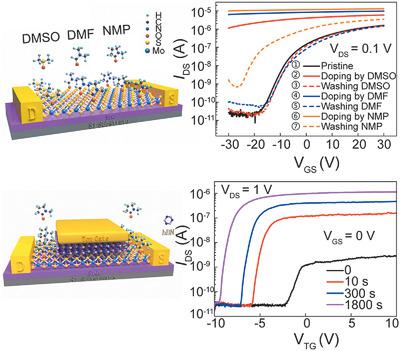当前位置:
X-MOL 学术
›
Adv. Electron. Mater.
›
论文详情
Our official English website, www.x-mol.net, welcomes your
feedback! (Note: you will need to create a separate account there.)
Controllable Doping of Transition‐Metal Dichalcogenides by Organic Solvents
Advanced Electronic Materials ( IF 5.3 ) Pub Date : 2020-01-22 , DOI: 10.1002/aelm.201901230 Xiao‐Kuan Li 1 , Ruo‐Xuan Sun 1 , Hao‐Wei Guo 1 , Bao‐Wang Su 1 , De‐Kang Li 1 , Xiao‐Qing Yan 1 , Zhi‐Bo Liu 1, 2, 3 , Jian‐Guo Tian 1, 2, 3
Advanced Electronic Materials ( IF 5.3 ) Pub Date : 2020-01-22 , DOI: 10.1002/aelm.201901230 Xiao‐Kuan Li 1 , Ruo‐Xuan Sun 1 , Hao‐Wei Guo 1 , Bao‐Wang Su 1 , De‐Kang Li 1 , Xiao‐Qing Yan 1 , Zhi‐Bo Liu 1, 2, 3 , Jian‐Guo Tian 1, 2, 3
Affiliation

|
Seeking controllable and efficient surface dopant molecules for transition‐metal dichalcogenides (TMDCs) is highly valuable for fully understanding TMDCs properties and their applications to relevant devices. The general doping effect of solvents on TMDCs are explored. By selecting suitable solvents with optimized relevant factors, controllable n‐doping of molybdenum disulfide (MoS2) is obtained on the same device with the sheet density of electrons increased from 2.3 × 1011 to 6.4 × 1012, 9.7 × 1012, and 1.6 × 1013 by use of dimethylsulfoxide, N,N‐dimethylformamide, and N‐methyl‐pyrrolidone (NMP), respectively. The doping principle is explained by charge‐donating characteristics of molecule and dipole interaction. After doping by NMP, the contact resistance is reduced by four times, and the on/off current ratio of fabricated top‐gated MoS2 transistors is increased by 3 orders of magnitude. This work can guide the selection of suitable solvents for effective doping of two‐dimensional materials and advance the development of precise controllable electronic and optoelectronic devices.
中文翻译:

有机溶剂对过渡金属二硫属元素化物的可控掺杂
寻求可控且有效的表面过渡金属分子以用于过渡金属二卤化物(TMDC),对于全面了解TMDC的性质及其在相关器件中的应用非常有价值。探索了溶剂对TMDC的一般掺杂作用。通过具有优化的相关因素,的二硫化钼(MOS可控n掺杂选择的合适溶剂2)在相同的设备上得到的电子的片材密度为2.3×10增加到11至6.4×10 12,9.7×10 12,和通过使用二甲亚砜,N,N-二甲基甲酰胺和N来获得1.6×10 13分别是甲基吡咯烷酮(NMP)。掺杂原理通过分子的电荷给定特性和偶极相互作用来解释。在通过NMP掺杂之后,接触电阻减小了四倍,并且制造的顶部栅极MoS 2晶体管的开/关电流比增加了3个数量级。这项工作可以指导为有效掺杂二维材料选择合适的溶剂,并促进精密可控电子和光电器件的开发。
更新日期:2020-03-09
中文翻译:

有机溶剂对过渡金属二硫属元素化物的可控掺杂
寻求可控且有效的表面过渡金属分子以用于过渡金属二卤化物(TMDC),对于全面了解TMDC的性质及其在相关器件中的应用非常有价值。探索了溶剂对TMDC的一般掺杂作用。通过具有优化的相关因素,的二硫化钼(MOS可控n掺杂选择的合适溶剂2)在相同的设备上得到的电子的片材密度为2.3×10增加到11至6.4×10 12,9.7×10 12,和通过使用二甲亚砜,N,N-二甲基甲酰胺和N来获得1.6×10 13分别是甲基吡咯烷酮(NMP)。掺杂原理通过分子的电荷给定特性和偶极相互作用来解释。在通过NMP掺杂之后,接触电阻减小了四倍,并且制造的顶部栅极MoS 2晶体管的开/关电流比增加了3个数量级。这项工作可以指导为有效掺杂二维材料选择合适的溶剂,并促进精密可控电子和光电器件的开发。











































 京公网安备 11010802027423号
京公网安备 11010802027423号